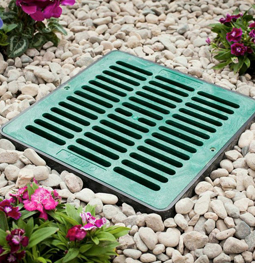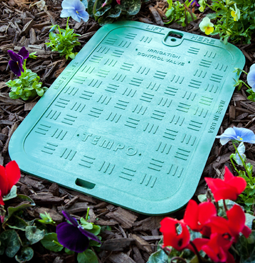
Download Tempo Drainage Installation Guide
This installation guide assumes that you have read the Drainage Design Guide and/or have a basic understanding of drainage design. Your design should be completed before you begin installation. A complete design will include details on grate and basin size and location, grate color, pipe type, pipe layout, pipe sizing, discharge location, etc.
Proper planning and design work ahead of time will help you minimize headaches and costs for your drainage system installation.
Before we get started
It is important to note that drainage system installation (including digging trenches and holes and backfilling) can be a strenuous physical activity. Be sure to evaluate up front whether you want to do it yourself or hire a qualified landscaping/drainage contractor.
Lastly, the most important point when designing and installing drainage systems is to take into account that drainage systems work on the principle that water flows downhill by gravity only. Not only does the piping network need to run downhill continuously towards the discharge point but the grate locations need to be located at low points on the property. These are the two most common mistakes homeowners make when they are designing and installing their drainage system.
If the natural topography of the area to be drained does not have the necessary fall, you will still need to dig a trench with the minimum slope required and then use a combination of low profile basins and catch basins, some of which will have one or multiple risers to make sure that grates end up at grade level.
You are now ready to begin the installation.
STEP 1:
Mark the Area
Before you begin to install the system, use a can of spray paint to mark where the piping and collection points (either catch basins with grates or just grates connected to the piping) will be located.
After you have marked the area, measure the total run of pipe and calculate the minimum required elevation drop, making sure that the change in elevation from the first collection point all the way to the discharge point will be a minimum of 1 ¼” for every 5’ of pipe, which is roughly equal to a slope of 2%.
STEP 2:
Dig the Trench
Use the piping layout you have just marked and start digging a trench approximately 6” wider than the size of the pipe you will be installing (this will allow approximately 3” of open trench on each side of the pipe).
Start digging the rough trench at the discharge point. Make sure you dig the trench to the correct depth at this point so as you work your way backwards to the furthest collection point, you are able to achieve the minimum elevation drop calculated in Step 1.
For larger projects, you will want to use a trencher. However, for smaller projects, a trenching shovel may be used.
Once the rough trench has been dug, use the following process to get a smooth continuous slope:
- Place stakes at 5-foot intervals in the trench. Use a hammer to secure the stakes in the ground.
- Tie a string to the first stake (at the discharge point). Wrap the string around the next stake making sure the string is taut but not too tight as to pull down the adjacent stake. Use a level to make the string horizontal.
- Measure the vertical distances from the string to the trench bottom at both stakes. Calculate the difference between the depths making sure that the minimum recommended slopes stated above are met (1 ¼” drop between stakes). Adjust the trench bottom as necessary to maintain a constant smooth slope between the stakes.
- Repeat this process for each 5-foot length of the trench.
If the slope of the run requires that the trench be more than 4’ deep, take precautions to shore up the walls of the trench so it doesn’t collapse. If you are trenching in a grassy area, cut out grass strips slightly larger than the width of the trench and set aside nearby.
STEP 3:
Dig Holes for Catch Basins
Now that you have dug the final trench, dig a hole for each catch basin. Dig the hole deep enough so that after 3” to 4” of compacted stone or gravel have been added to the bottom of the hole, the basin outlet(s) line up with the bottom of the trench.
If installing a 9” or 12” catch basin, and the depth of the trench is too shallow to allow the grate to be at grade level, a low profile basin (BS9LP or BS12LP) should be used instead.
If installing a 9” or 12” basin, and the depth of the trench is too deep to allow the grate to end up at grade level, risers (ABR9 or ABR12) may need to be stacked on the basin to bring the grate to grade level. Keep in mind that multiple risers may be used together to achieve the correct height. Each riser increases the grate height by approximately 6”.
If installing a 6” basin, and the depth of the trench is too deep to allow the grate to end up at grade level, cut a length of 6” PVC pipe and add to the top of the catch basin. Cut the pipe to the correct length so that the grate after being installed in the pipe reaches grade level. The grate may be attached directly to the top of the pipe, but for a better fit, use a 6” coupler between the grate and pipe.
Note: Install the basins, low profile basins and risers so that each grate will be recessed below grade at approximately 1/8” for non-traffic installations and 1/4” for traffic installations.
STEP 4:
Install Basins
Add 3” to 4” of compacted stone or gravel in the hole you have already dug for the basin. Spread out the stone or gravel making sure that the base of the hole remains flat.
For heavier duty applications where light auto traffic may occur or for hot mastic applications, catch basins should be encased in concrete to prevent distortion. If installing basin in concrete, make sure to tape over the inlets and outlets of the basin to prevent concrete or other debris from entering the basin.
Before placing the basin in the hole, install necessary adapters and plugs in the square catch basins or low profile basins (not needed for 6” round basins). Use a 3” or 4” Basin Adapter (ABA34) if you will be connecting to 3″ & 4″ Sewer & Drain Pipe (ASTM D2729), 3″ & 4″ Corrugated Pipe or 3″ & 4″ Triple Wall Pipe. Use a 6” Basin Adapter (ABA6) if you will be connecting to 6″ Sewer & Drain Pipe (ASTM D2729) or 6″ Corrugated Pipe. Use a Basin Plug (ABP) to plug any unused openings.
To cut out the four optional drain holes on the bottom of the square basins, we recommend using a 5/8” hole saw. This will allow standing water to leach out.
Now the basin (6” round or 9”, 12” or 18” square catch basin) is ready to be placed in the hole. If you are going to be using a low profile basin, this gets done in the next step. Once the basin is placed in the hole, make sure that the outlets will be aligned with the pipe.
Install selected grate on to the catch basin. Secure grate to basin using # 6 x 1.5″ flat Phillips head stainless screws.
STEP 5:
Connect Pipe to Each Basin or Grate
Connect the pipe to the inlet and outlet of each catch basin. If using a low profile basin, connect the pipe directly to the bottom of the basin using the basin adapter you already attached in Step 4. Corrugated pipe will snap directly into this adapter while PVC pipe will be a press fit.
If no basin will be used, connect the pipe directly to the selected grate using the appropriate stepped diameter on the base of the grate. Triple Wall Pipe fits on to the smallest diameter, Sewer and Drain Pipe and Corrugated Pipe fit on to the middle diameter and Sewer and Drain Pipe hub fittings fit on to the largest diameter. For corrugated pipe, you may want to use duct tape to make a more secure connection.
STEP 6:
Connect the Pipe Network
Connect the rest of the pipe and fittings together using a press fit for PVC pipe or snap fit for corrugated pipe. Make sure there are no humps in the pipe that could affect the flow of water.
You should now test the system to make sure water flows properly towards the discharge point and also check for any leaks. The easiest way to test this is to run water into each grate making sure that the water drains efficiently, flows in the right direction and exits at the discharge point.
If you are satisfied with the way your drainage system is performing, you may now want to glue the PVC pipe and fittings together. PVC primer and medium body fast set PVC glue may be used to bond all PVC pipe to fittings. For corrugated pipe, it is highly recommended to use duct tape to secure the components.
Note that the drainage system operates at low pressure and therefore bonding of PVC components is not essential.
STEP 7:
Backfill the Trench
The next step is to backfill the trench with the soil that was previously removed. Once the soil is replaced, it must be compacted well (using a plate compactor if necessary) to eliminate any void spaces. In time, any voids left in the soil will settle and could cause future drainage problems.
Once the soil has been replaced and compacted, replace the grass that was previously removed.
Residential Downspout Catch Basin Installation
It is common for homeowners to direct their downspout water from rain gutters into a pipe that travels directly to a discharge point. This often leads to clogged drainage pipes. Over time, debris and sand particulate from the roof will build up in the pipe and reduce drainage efficiency. A catch basin helps to reduce this problem in two ways. First, the grate that covers the basin will filter out the coarsest debris. Second, any debris that passes through the grate will be caught in the sump of the catch basin which can easily be cleaned out at any time. It is recommended that for this application the catch basin be encased in concrete.



